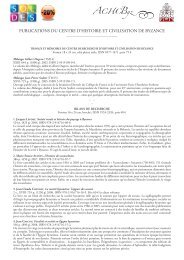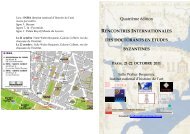booklet of abstracts - Oxford University Byzantine Society
booklet of abstracts - Oxford University Byzantine Society
booklet of abstracts - Oxford University Byzantine Society
You also want an ePaper? Increase the reach of your titles
YUMPU automatically turns print PDFs into web optimized ePapers that Google loves.
Session Eight11:30 | Saturday 5 March 2011 | Rees Davies RoomChairCaterina Franchiexeter CollegeThe Politics <strong>of</strong> Memory andVisual Politics: Comparingthe Self-representation <strong>of</strong>Constantine and AugustusMariana BodnarukCentral European <strong>University</strong>, BudapestExamining the imperial politics <strong>of</strong> memoryhelps elucidate the social, cultural and politicalchanges which occurred in the Roman world inLate Antiquity. The crisis <strong>of</strong> the third centuryAD accelerated processes <strong>of</strong> transformation thathad begun in the late Roman period, particularlyin the urban spaces <strong>of</strong> Rome. Especially inthe early fourth century, the conversion <strong>of</strong> theemperor Constantine to Christianity, as well asthe structural transformations <strong>of</strong> the Romanempire, which are revealed through an analysis<strong>of</strong> the politics <strong>of</strong> memory together withvisual politics, forced Roman society to cometo terms with the religious and political consequences<strong>of</strong> the newly-Christian empire. TheEusebian model <strong>of</strong> emperor, state, and churchwhich emerged from the fourth century eventuallywon out and, though it was questionedin Late Antiquity, became the basic politicalmodel for Byzantium.This paper will focus on the followingquestion: What were the similaritiesand differences between Constantine’s andAugustus’ modes <strong>of</strong> self-representation?Structural analogies between Augustan andConstantinian exploitation <strong>of</strong> visual language,as well as Constantine’s own appropriation<strong>of</strong> a pre-existing imperial visual repertoirefor self-representation, explicate the waysin which emperors engaged in a politics <strong>of</strong>memory to relate to the past. Did Constantinerelate to the imperial past, the Tetrarchy inparticular, as Augustus did to the Republicanpast? Thus, a fundamental formulation follows:the study <strong>of</strong> the imperial politics <strong>of</strong>memory helps explain the massive changesto the Roman empire in Late Antiquity. Thispaper will specify necessary limits on this critique<strong>of</strong> political ideology.Mariana Bodnaruk is an MA studentspecialising in late antique, <strong>Byzantine</strong>, andEarly Ottoman Studies in the Medieval StudiesDepartment, Central European <strong>University</strong>.Her research interests cover Late Antiquity,early Byzantium and cultural and memorystudies. Her previous topics <strong>of</strong> focus wereissues <strong>of</strong> memory and forgetting, particularlymemory in imperial culture, which led her tothe broader field <strong>of</strong> late antique and <strong>Byzantine</strong>cultural and art history.Cities <strong>of</strong> God: Space and Memoryin Victor <strong>of</strong> Vita’s History <strong>of</strong> theVandal PersecutionLuke GardinerCorpus Christi College, CambridgeBeyond the Vandals’ conquest <strong>of</strong> Carthage,their progressive co-option <strong>of</strong> manyRomano- Africans pr<strong>of</strong>oundly shook theconfidence <strong>of</strong> certain leading Catholic clerics.This paper will show how one cleric,Victor <strong>of</strong> Vita, contested factors he perceivedas crucial to this co-option (and thewider project <strong>of</strong> the legitimation <strong>of</strong> Vandalrule), from Vandal appropriation <strong>of</strong> thesecular and religious loci, landscapes, andideology on which much North African(and) Catholic identity was predicated, to22 | Between Constantines





